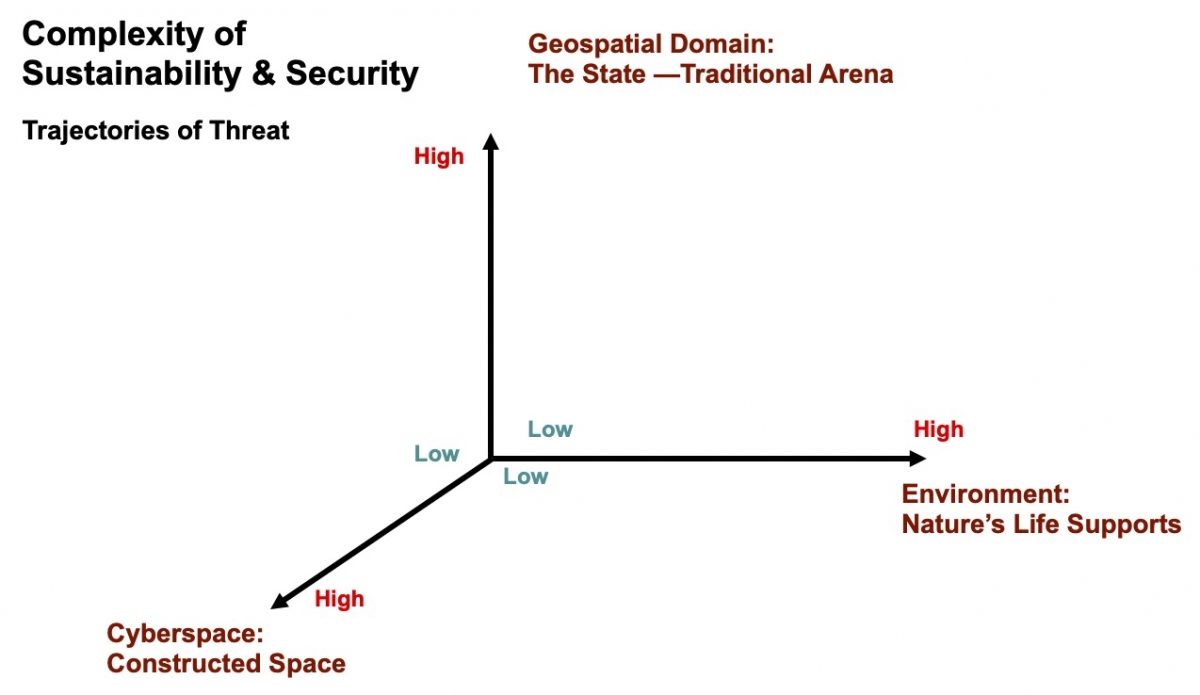My theoretical focus is on the dynamics of transformation and change in international relations articulated in the theory of lateral pressure—introduced by Robert C. North. Lateral Pressure theory seeks to explain the relationships between state characteristics and patterns of international behavior. The theory addresses the sources and consequences of transformation and change in international relations and provides a basis for analyzing potential feedback dynamics.
What is Lateral Pressure?
Lateral Pressure refers to any tendency (or propensity) of individuals and societies to expand their activities and exert influence and control beyond their established boundaries, whether for economic, political, military, scientific, religious, or other purposes.
Lateral pressure is a relatively neutral concept similar to what Sorokin (1957, 565) called economic expansion and Simon Kuznets (1966, 334–348) referred to more broadly as outward expansion. The strength of a country's lateral pressure is generally taken to correlate positively with its power as conventionally understood. Developed with Nazli Choucri, the theory addresses the sources and consequences of such a tendency.
Lateral pressure theory provides a more detailed and nuanced view of the sources of power, the types of leverages used, and the behaviors that can be inferred. It suggests how certain types of international behaviors or activities appear to be more prevalent in some countries than others. Among the notable reviews of lateral pressure theory are Levy (2005), and Pollins and Schweller (1999).
The theory draws on the level of analysis or "Image" perspective in international relations (Boulding 1956; Waltz 1979), largely as an initial framing, and then extends this traditional perspective in specific ways. (Choucri and North 1972; Choucri and North 1975; Ashley 1980; Choucri and North 1989; North 1990; Lofdahl, 2002).
New Fundamentals
Traditionally, international relations theory has focused on power and purpose in the geospatial domain, with the state system as the dominant organizational principle. In contrast to tradition in international relations, lateral pressure theory takes the position that all actors and entities are embedded in three interconnected systems namely the social system and its physical properties, the natural system and its life supporting properties and, more recently, the constructed cyber system and its enabling potentials for all actors and entities worldwide.
Growing scientific evidence of the human impact on the natural environment called into question the human-centric view of our world and its forms of international relations. Then, too, the construction of cyberspace, with the Internet at its core, enabled and forged new venues of interaction, as the virtual domain assumed salience in human interactions—and in relations among states and other entities worldwide.
By the end of the 20th century, changes in the world around us—the "empirical realities" as well as methods, policies, and practices—contributed to a reframing of fundamental principles, assumptions, and expectations, and in international relations theory, policy, and practice. My theoretical approach to international relations is explicitly anchored in a now obvious and powerful "reality," namely that all humans are embedded in three distinct interconnected systems—"spaces" or domains—that jointly shape an overarching framework:
- The social system with all forms of human interactions, order and disorder
- The natural environment with life supporting properties and various forms of life
- The constructed cyberspace with the Internet at its core and rapid changes in its structures, processes, and configurations.
The overarching frame is "set," so to speak, by the parameters of these systems. Individuals, groups, or other aggregations do not have the choice of "opting out" of the social system nor of the natural environment and, at this time, few select to "opt out" of the cyber domain. Each system harbors forms of complexity as well as degrees threats to security and sustainability.
The Figure below illustrates, in highly stylized form, the defining trajectories of human interactions and the adjacent “spaces” between them.
 |
|---|
| New fundamentals: high-level view. |
The relevance of the Figure above for international relations is illustrated in the next figure with annotations along the trajectories.
 |
|---|
| Illustrating trajectories & adjacent "spaces." |
It is fair to say that the major challenge – for theory, policy, and practice – is to understand the processes and, to the extent possible, the interactions and intersections along the trajectories and the adjacent “spaces”
Clearly, both Figures presented are "static" in form. They are not intended to represent transformation and change in international relations. But framing the fundamentals is a first step in the long path research, empirical analysis, and theory testing and development—bits and pieces, one step at a time.
Simple as that might seem, this basic "reality" generates complexities and uncertainties in almost all aspects of international relations. More important, however, it generates new challenges as we consider "system boundaries" for any issue of industry and at any level of analysis. Porosity is the rule, not the exception; and interconnection is the defining feature for trajectories of the overarching global system.
Reference:
- Choucri, N., & Agarwal, G. (2017). The theory of lateral pressure: Highlights of quantification and empirical analysis
. In W. R. Thompson (Ed.), The Oxford Encyclopedia of Empirical International Relations Theory. Oxford University Press.